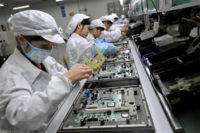Automating Assembly—A Crucial Step for Day One

If you are in the business of building semiconductors, one Zoom conversation that you will never have is: “Hey, when do we think is the best time to automate this?” Since roughly 1980, every electronic product you could imagine has been made possible because of automation. At all levels—from design to the billion-dollar fabs through to the million points of testing—automation is there from the beginning.
Automation is and should be an assembly prerequisite, rather than an enhancement of a traditional practice. Some industries succeed at this. Take welding lines in an automotive factory, as an example. Just like semiconductors, these lines are fully automated from day one. While there’s plenty of essential work to keep that line optimized and robust to change orders, the welding task itself is only happening because it is automated. However, in many industries, automation is an afterthought—considered only after a process is stable, “everything works,” and an organization assesses the “risks and paybacks.”
The Value in Early Automation for Assembly
Looking at a common scenario in device assembly helps to demonstrate the value of early automation. Let’s say our team is working together to bring a new medical tester to market. From the CAD model, it appears to be a standard board-in-a-box build with parts placement, screwdriving and connector attachment operations. However, a closer look reveals that there are some small optical parts that require alignment and wetted parts that need to be glued and sealed.
We follow the sequential builds (engineering, design and production validation tests) that we are trained on. We do all the assembly operations by hand—engineers and technicians working side-by-side—until we have a few hundred ready for testing. Many weekends are invested in working through all the intricate assembly steps, and the product launch date keeps slipping. Somehow our product survives to volume production.
When we visit the factory two years later, we’re surprised to find that many of the previously manual steps are now automated. Looking at the HMI’s, we see parameters that are familiar from our year of lost weekends, and a colleague suddenly says: “All of these variables tracked here in volume production sure would have been helpful to have a dial on when we were figuring this out blind a few years ago!”
Indeed. And if we were in another industry, they would have been! We always think of automation as something good for achieving speed. But there’s much more value in speed than we give it credit for: Critical speed means that not only are we producing more units per day, but we are also also speeding through the risky and expensive ramp-up interval, and only then into stable volume production.
Proving the Cost Concern Wrong
As the scenario demonstrates, pulling in automation earlier can expose problems and track critical parameters to smooth sailing through to volume production. Then why do some manufacturers not leverage automation early on? Usually, it comes down to cost. Manufacturers worry that early assembly automation will slow down the build progress and will be far too costly to maintain for the long haul.
Contrary to this line of thinking, automation, when leveraged early, pays for itself.
Consider adhesive dispensing, for example. People have been gluing things together for hundreds of years, and yet adhesive dispensing remains a challenge when it is added to assembly lines. Variables such as humidity, surface condition and physical size differentiators are all invisible on any given final assembly. The only way to have high yields with adhesives during assembly is to systematically adjust those variables. It is common to use a programmable motion system for dispensing, but the physical assembly often has just as many variables. It’s a lot like building a sandwich. Even if the peanut butter is applied perfectly, variations in the bread slice and speed, angle, force and assembly time all affect quality. With a modern automated system for dispensing, inspection and assembly, changing these parameters in a consistent interface means anyone can help with the process iteration.
Micro-assembly is another example. Consider the assembly of something minuscule, like a small lens in front of a chip (commonly used for a device like a phone, sensor or medical device). As magnification increases, the depth of field decreases. For 3D assemblies smaller than about 1 millimeter, not even a fancy microscope can assist much in precision efforts. Typically, the best way to tune things is by letting the errors stack up and then measuring the final subassembly. This is a painstaking process that is tremendously difficult to scale in the absence of automation from day one.
Early automation shouldn’t be an afterthought for product assembly. When leveraged early, automation allows for rigorous process development, seamless retooling, and ultimately gets products to market faster. So, the next time you are looking over renderings of your next significant product offering and figuring out what can be done to push the program to the next level, consider where your automation journey starts and how far it can take your company. Next-generation, flexible automation is already here and can assist your assembly line—from day one and beyond.
Eric Johnson is the director of innovation at Bright Machines where he is focused on developing technologies for software-defined automation. With two decades of experience as a mechanical engineer, he’s worked on a range of challenges, including world-first products at Google and Mojo Vision. Eric’s interest in using modern manufacturing technology to transform an industry began when he co-founded Skyline Solar, and it continues to drive his work today.
Looking for a reprint of this article?
From high-res PDFs to custom plaques, order your copy today!





